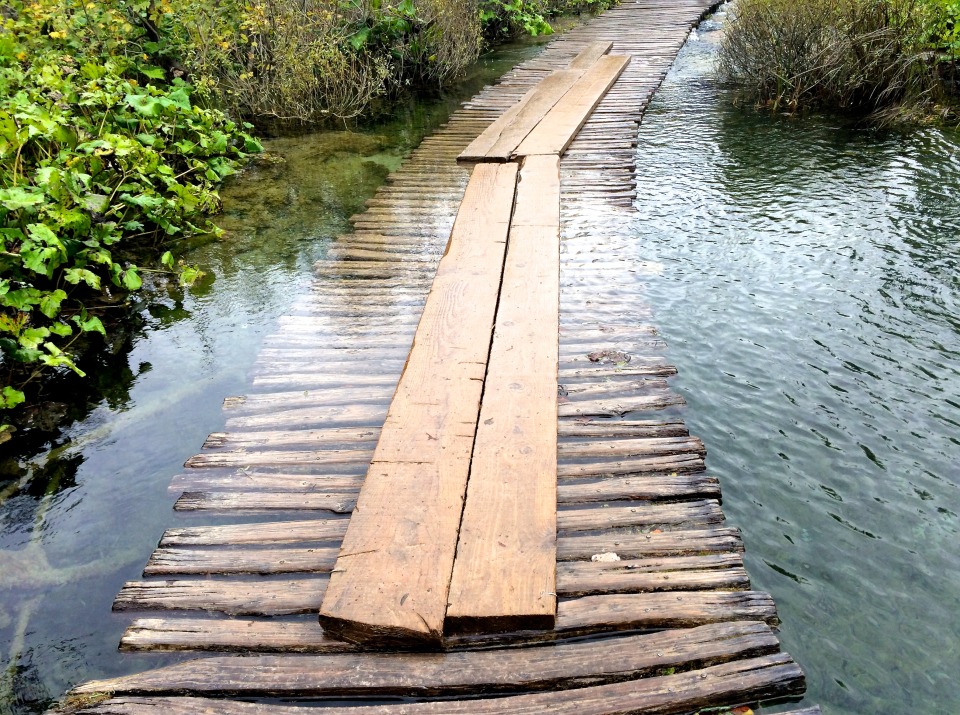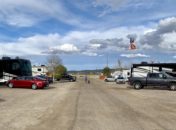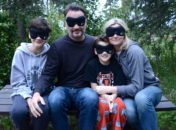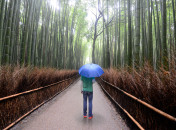Croatia was a tabula rasa for me. I knew it was part of the former Yugoslavia and that it inhabited a long stretch of beachfront along the Adriatic, which I imagined was beautiful. I heard from several sources including my wife that much of “Game of Thrones” has been filmed there, but I still had no solid mental or visual framework for the country. I considered doing a Google image search for Croatia, but the results of those kinds of searches yield only a superficial viewpoint (do a Google image search on St. Louis, Missouri for example and you’ll see hundreds of pictures of the Arch). Into the unknown I headed…and worse, on a bus.
GET ON THE BUS
We met our first bus at Tronchetto Island near the end of the people-mover elevated tram on Venice. The “bus” was a small, 14-person Sprint van and we were the only passengers at the initial pick-up point – for a few moments, we considered the possibility that our entire five-hour trip would be a personal shuttle. I couldn’t ask, as our driver was a nice middle-aged guy who grinned a lot, but spoke no English – only Croatian. I only knew “thank you” (hvala) and “good” (dobro), having gathered those necessaries the night before. Truth is, you can get pretty far in many parts of the world with only the local word for “thank you.”
Our hope for an empty shuttle was short-lived as we picked up a few more passengers on the Italian mainland. For the first hour, we traveled along a major four-lane highway that didn’t offer much of a view of the subtly changing terrain. We stopped to change buses in Trieste, Italy, which is on the opposite side of the Adriatic Sea from Venice. Most of the other passengers were Croat nationals who seemed to be commuters from work at the many resorts in Trieste – they carried special badges to expedite border passage when we entered through Slovenia and into Croatia. The sour-looking border agent looked at our passports grimly, flipping through all the pages to see what other countries we’d visited and even held up the pictures near our faces to make a visual confirmation of our identities. I doubt many American families enter the country via a mostly commuter bus.
THE LANDSCAPE CHANGES
We approached Pula, Croatia in the late afternoon. The terrain was different from the other places we’d been on the trip, with a lot of low trees and shrubs and light gray limestone rocks strewn about. Groves of olive trees cloistered behind stone walls and simple wooden gates. Ruined barns with missing roofs and surrounded by Mediterranean cypresses marked boundaries of farms up the hillsides. At the bus station we grabbed a taxi out to the airport to pick up our rental car.
The roads in Croatia were amazing. They were all very new (so new they often didn’t show up in our GPS) and smooth, well-marked and virtually empty. Other than in the central towns, we didn’t come across many other drivers at all. That said, those drivers were quite loose in following the rules of the road – yielding the right-of-way seemed optional, speed limits were suggestions and lanes were fluid. I had to give way to a lot to oncoming traffic performing unsafe passes on two-lane roads, and learned quickly to be the most cautious driver in Croatia.
After a 45-minute drive we arrived at our apartment in the village of Rovinj, a hot tourist destination in the summer and an active fishing hub year round. Since we were there in October, most of the streets and restaurants were empty. The ancient and beautiful Old City sits on an egg-shaped island (or used to, as the citizens filled in the narrow channel in the late 18th century). It was originally inhabited by one of the Illyrian tribes and has been a jewel for conquering empires for the past 2,000 years, including the Kingdom of Italy as recently as 1911 – a fact that reveals itself in local restaurant offerings.
Our apartment was perfect, nestled deep in a neighborhood far away from the tourist hotels and with a terrace overlooking a small yard of fig trees and grapevines. Our wonderful hostess Ljiljiana had pre-stocked the fridge with local beers, juices, milk and fruit. She made recommendations for places to eat in town, and after a short walk we settled at Aqua II. The restaurant patio looked past corrals of empty tables and chairs out onto the harbor. Our waitress brought us bread with olives, cheeses, and a cucumber dip that was outstanding, and the pizzas and pastas were all just as good.
The next day was rainy and cool, and our super comfortable beds and the patterned rhythm of raindrops against the metal table on the terrace made it easy to sleep in. The forecast called for a heavy rain all day, but in hopes of a short break we finally geared up and drove to Pula to visit the locally famous amphitheater.
ARE YOU NOT ENTERTAINED?
It was raining hard when we arrived in Pula, and the narrow cobblestone streets worsened by a lagging GPS equaled an angry Mark until we oriented ourselves to the town’s grid. Pula is a very old city situated on the southern end of the Istria Peninsula, in a well-protected and deep-water bay. It has documented human settlements as far back as 11,000 years ago, but we were much more interested in its recent Roman past. We were headed to Pula Arena, an amphitheater constructed in the first 100 years of the Roman Empire. It is one of the six largest Roman arenas in the world.
Although the arena’s age should have earned it some reverence, in honesty we showed up as three American boys with wooden swords, ready to play. The security guard eyed us suspiciously as we paid our Kuna and entered the arena. For 20 minutes we were alone in the stadium, and Angela watched from the spectator seats as two gladiators (ok, Asher and me, him with the eye of the tiger) fought to the death.
CROATIAN IS HARD TO GUESS
We play games to figure out foreign languages, working together to decode labels and signs. A big apricot on the side of a jar marked “abricot” is easy – apricot jelly, of course. But Croatian packaging was completely obtuse, as their words aren’t Latin-rooted. Our search for strawberry jelly, peanut butter, ham, butter and milk was a humorous one, as we had to decipher “jagode mliječ,” “maslac od kikirikija,” “šunka,” “maslac,” and “mlijeko.” What we lacked in language skills was made up through a methodical process of elimination … and a lot of patience.
Our Rovinj apartment had the relaxed feel of a friend’s extra room and the town had more smiles than fishing nets. Old Town Rovinj is a UNESCO World Heritage Site where cars are not allowed, but the rain had kept us from visiting so we awoke extra early to have time to walk its streets before heading south. The cobblestones were slick with sea fog and the coffee houses were filled with loud, red-eyed fishermen who’d already returned from sea with the day’s catch. A cup of coffee, a few cigarettes and a croissant, and they would head home to sleep. We slipped through the labyrinthine streets where seagulls screamed over breadcrumbs to the top of the lone hill where Saint Euphemia’s Basilica stands. There, a clumsy-footed puppy and her owner played fetch in front of the white bell tower modeled on St. Mark’s in Venice.
No one was on the new toll roads in Croatia, whether because they didn’t want to pay the fee or because no one (including our GPS) knew they existed, we couldn’t guess. Nor did we care, as having an entire four-lane highway to ourselves made a rather long drive somewhat more relaxed. We’d spend that night in the city of Split, but we planned to visit Plitvička Jezera Naticionalni Park along the way, which sits near the mouth of the incurvate boundary of Croatia’s inland east. As we neared neared the park, the terrain became more arborous and colorful and the roads more rustic, and we discovered that Croatia’s potholes and soft shoulders mostly reside in the countryside.
The GPS had us exit the main motorway onto a narrow country road, a counter-intuitive directive that both Angela and I doubted yet followed. “Must be a back entrance,” I said as the GPS guided me into the deep forest. For almost 20km I steered my most valued possessions down a one lane, potholed, rain-slicked and partially flooded road through the mosquito-infested and isolated valley. I knew something wasn’t right by the confounded expressions of the farmers we passed. Sure enough, we rounded a blind corner and screeeech! A giant steel gate blocked our path.
PLITVIČKA JEZERA NATICIONALNI PARK
We recovered from our unintentional ramble and finally found the proper entrance to the park. Plitvička Jezera Naticionalni Park is reminiscent of the karst terrain of the Ozarks – springs, influent streams, sinkholes and caves. Everywhere we walked, moss-covered white travertine jutted out of the soft loam; some of the sinkholes were 20 meters or so deep. The forest of beech, maple and sycamore was aflame with seasonal color. We took a shuttle to the top of the park, where we started a gradual descent along roughhewn boardwalks and gravel trails past the lakes, streams and waterfalls that make the park so unique.
Simply put, Plitvička Jezera was one of the most beautiful places we’ve ever seen. Once on its trails, we no longer cared when we would arrive in Split or whether we’d have dinner. Like some of our off-the-beaten-path moments in the U.S. or Iceland, we mostly had the place to ourselves. Boardwalks crossed over pools, streams and along the edge of the many falls. Recent rains meant water bubbled up from between the slats at our feet, and the jade and turquoise pools over which we walked were easily 20 feet deep. We walked and climbed for hours until our chief concern was darkness and the gathering clouds above.
We settled in for a three-hour drive to our hotel in Split, guided by the western sky streaked indigo and orange and red. With each kilometer, the sea breezes of the Adriatic lighten the spirits of our weary family.
CLICK ANY PHOTO TO OPEN THE GALLERY.


























































